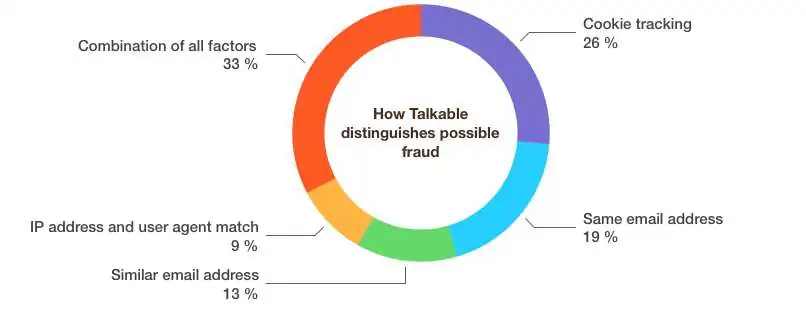Referral marketing provides a unique opportunity for businesses to tap into their existing community to gain new customers. However, one thing to be aware of is referral program fraud. There will always be a small percentage of people gaming the system as there is with any discount, affiliate, or other marketing programs.
The Juniper report research found that eCommerce retailers have lost $17.5 billion in 2020 due to fraud and that the dollar amount of e-commerce fraud is projected to increase by 18% in 2021. Fraudsters are increasingly trying to cheat referral and loyalty programs.
With that being said, how can eCommerce brands be prepared and protect themselves from the fraud? Let’s start from the beginning and talk about what referral marketing fraud is, learn the different types of fraud.
What is referral marketing fraud?
You may naturally connect fraud with phishing scams that try to obtain people’s personal information. However, referral marketing fraud is something different.
Referral fraud is when a buyer attempts to leverage the current offering by trying to hack the process to get numerous incentives.
For example, trying to self-refer yourself by providing one of your other emails is considered referral marketing fraud. Self-referrals are a common type of referral marketing fraud because one person gets the rewards an advocate would receive and the rewards of a referred customer.
Referral fraud is the one downside of the awesome effects that referral marketing can bring to your e-commerce businesses. In our opinion, the benefits of referral marketing far out way the downside of referral marketing fraud.
4 Different Types Of Referral Fraud To Look Out For
People who are trying to game the system can do multiple things to get a deal. Referral fraud is not just limited to someone referring to themselves. Here are the most common types of fraud:
- Self-referral: When advocates refer themselves by creating fake accounts to take advantage of the referral incentive.
- Exploitation: unknown internet users that develop referrals for personal monetary gains.
- Account Cycling: users sign up for a reward and then cancel their account.
- Broadcasting: when advocates share their referral coupons on websites (like Reddit) that are not approved by the e-commerce business offering the rewards.
You can’t say people aren’t creative when trying to get a deal. However, it’s essential for a retailer to reduce referral marketing fraud, since it can affect referral program performance.
Why You Need To Look Out For Referral Marketing Fraud
Obviously, you want your referral marketing campaign to do its job and grow your new customers and generate revenue. When fraud occurs, this can eat into your success metrics. Three of the most common ways that fraud can hurt your business is seeing false numbers, losing profits, and losing time.
- Inflated Numbers:
When more transactions are occurring, and you’re not seeing new accurate and unique customer information this is a sign that people may be referring themselves. Inflated numbers affect how exact your numbers are and the ROI of your referral campaign.
- Lost Profits:
If fake accounts are able to redeem refer-a-friend offers, this can really cut into your profits. Instead of rewarding a friend for a first-time purchase for $5, you will be losing $5 to a fraudster with multiple accounts.
- Lost Time:
Once, your business notices potential fraud occurring, your team has to look through the new users and look for fake accounts manually. The more automation you can use in the process, the faster the fraud prevention would happen, saving your team’s precious time.
How You Can Prevent Referral Program Fraud
Now that you know what referral marketing fraud is, how do you prevent it? Manually reviewing each new user won’t work (or would take forever).
One of the easiest ways to prevent fraud is by using a referral tracking system that deters fraudulent behaviors. When you’re picking a referral marketing program make sure that it has fraud prevention. Talkable provides end-to-end fraud prevention and quality control engine where you and your dedicated customer success manager can define the rules to catch and prevent fraudulent behaviors.

Here are nine foolproof methods that can help your business reduce referral marketing fraud:
1. Verify that Advocates are Existing Customers
If you only want current customers to earn your incentive offering, then your business needs to verify that they’ve been a buyer. You can run segmented referral campaigns that only show past customers the offer or have Talkable check customer emails by running it through your client’s customer base. Also, we make sure to verify that the referred friend is not an existing customer and is indeed new to your business.
2. Ensure Rewards are Received Only Once by Tracking Cookies
Tracking cookies enables you to determine if someone from the same device using the same browser at the same location is trying to access your referral for the second or third time. Utilizing cookie tracking is one of the best ways you can stop the same person from redeeming multiple referral rewards
For example, an advocate visits a campaign page for the very first time, Talkable generates a unique identifier for this person and saves it into the browser as a cookie. Later on, when the friend visits the Friend Claim page and has the same identifier as the advocate, Talkable assumes this is a self-referred advocate.
3. Use Manual Approval as Your Final Check
If you’re determined to put an end to referral marketing fraud, manual approval may be one of the ways to make that dream come true. With Talkable, we offer flexibility in our fraud settings. Based on the criteria you deem fraudulent behavior, our software can skip, flag, or block requests. Under manual approval, your team will go through the flagged requests to determine whether they are fraudulent.
This means you’ll need to assign a dedicated team member to approve every single request for your campaign. On the bright side, your team will have the final say on whether advocates receive their reward or not. By manually approving referrals, you can double and triple-check that both the advocate and friend are eligible for the reward.
Although manual approval helps reduce and almost eliminate fraud entirely, the manpower you’re dedicating to this process may not be worth the money you’re saving in reward costs. Whether or not you implement manual approval should be determined by how much you want to ensure the accuracy of incentives delivered and how many requests you’re receiving.
4. Pay Attention to IP Addresses
IP addresses are a series of numbers that pinpoint the computer or device connected to a visitor’s network. Just like your home address tells people where you live, an IP address provides information on each device that is connected to computer networks.
By monitoring IP addresses, you can see if the same IP address tries to make repeat purchases. Although multiple attempts from the same address do not necessarily mean you should automatically be concerned, you can set up rules and quality controls with Talkable to flag this behavior. In fact, we would suggest you put that rule in place, but keep in mind someone in the same household can refer a family member or colleague from the office, and this could be a reason for this type of behavior.
5. Setup the Right Referral Rules for Your Campaign
If you want to be extremely careful and prevent fraud, you must implement certain referral rules. For example, with the Talkable platform, you can select our rules to skip, flag, or block specific actions. Here are a few examples of rules you can enact:
Similar Email Match
If someone uses the email jane.doe@gmail and then jane.doe123@yahoo, our system can flag or block them. Since it looks like someone created another email or used a secondary account, Talkable can recognize that and ask you to look into the situation or mark that this person won’t receive the referral.
Physical Address Match
The physical address match comes into play when your customers enter their shipping information. If you have multiple customers using the same home or work address, you can also use this as criterion to flag or block a reward. However, keep in mind apartment buildings, and dorms are listed under the same address so multiple people may be using the same location
6. Limit The Number of Rewards Advocates or Friends Can Receive
Another way you can prevent referral marketing fraud is to limit how many times advocates and/or friends can earn a reward. By capping the number of times, someone can receive incentives will help prevent fraud. People who are trying to get as many rewards as possible will be stopped at the particular limit you’ve determined.
Now, this can be a bummer for your top advocates who are genuinely promoting your business. To make everyone happy, segment your top advocates and offer them a specialized, unique campaign just for them. This way, you can still reward your best referrers while reducing fraud at the same time.
7. Use Coupon Codes for Rewards
A great tip to preventing referral fraud is to make your offer a coupon code. Coupon codes are the easiest to monitor because you can apply even more restrictions with them. Plus, coupon codes are simple to revoke, add expiration dates, and put on limits for minimum order values that will prevent users from attempting to defraud your program.
8. Delay Reward Emails and Referral Links
It might sound counterintuitive, but delaying sending out your reward emails or referral links can help diminish referral fraud. When there is a wait for people to receive their incentives, those who are trying to game the system are less likely to do so after more time has passed. By delaying their deals, scammers decide that it’s not worth the effort or they don’t want your offer enough to wait for it.
9. Utilize a Trustworthy Referral Software That Detects Fraud
Now, this might sound obvious but using the right referral marketing platform can make a huge difference. Not all referral platforms are created equal when it comes to their fraud prevention rules and quality controls. Talkable can help you employ all of these tips to reduce fraud and many more. To learn about our fraud prevention engine take a look at our referral approval document.
We hope these best practices have equipped you to reduce fraud in your referral program. There are many options to choose from, and it’s all about knowing what will work best for your team, your business and most importantly, your customers.





